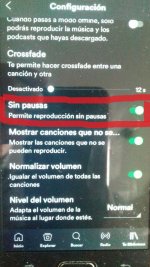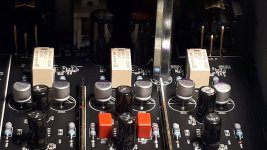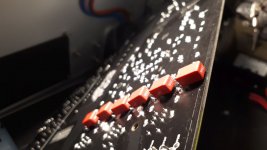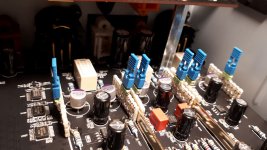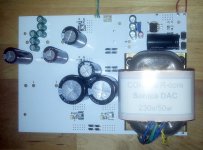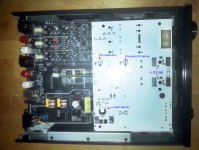I just received the answer from Oppo to my concerns, I transcribe them below:
" The Sonica DAC outputs analog only, so you will not be able to take an analog signal and then convert it to digital. So the Sonica DAC can take an analog signal and then digitize it for volume control and distribution to a Sonica speaker, but the Sonica DAC can't store that digital file or output a digital signal for another device to capture. "
As always, an excellent after sales service for your excellent products, which like everything good, will maintain its prestige for many years ..
HIGH PERFORMANCE AUDIO
Top-of-the-line Digital-to-Analog Performance
With more and more music coming from digital sources, the DAC is one of the most important components for digital audio playback. OPPO Sonica DAC is equipped with an ES9038PRO 32-bit HyperStream DAC chip at its core. The flagship of the ESS SABRE PRO series, ES9038PRO sets a new benchmark for audio excellence.
Clean Power for Clear Music
Sonica DAC’s audio circuitry is supplied with a linear power regulator drawing from a massive toroidal power transformer. A toroidal power transformer offers superior power efficiency and much lower exterior magnetic fields over traditional laminated steel core transformers. The toroidal linear power supply provides a very clean and robust power source to the audio components.
Fully Balanced Design for the Best Signal Quality
Sonica DAC’s audio output path is fully balanced from the DAC chip all the way to the XLR jacks. Even the RCA output signal is converted from the balanced output. The balanced design provides better common-mode noise rejection and improves signal quality. It also provides better channel separation by eliminating the common ground return path.
MUSIC WITHOUT LIMITS
Play and Stream High Resolution Music
Play music files of many formats from USB drives attached to the Sonica DAC, or from home network computers and servers connected via Ethernet or Wi-Fi. Stream music from your smartphone and tablet via Wi-Fi using the Sonica app. The Sonica DAC is a high resolution audio player and decoder capable of decoding audio files up to 24-bit / 192 kHz from formats such as FLAC, WAV and Apple Lossless, as well as DSD files at 64x sample rate. (A smartphone or tablet running Android or iOS is required.)
Apple AirPlay and Bluetooth
Sonica DAC supports Apple AirPlay, which lets you wirelessly stream your music from iTunes, an iOS device, or an OS X computer to Sonica through your Wi-Fi network. Bluetooth is another convenient way to connect your mobile device or laptop computer to Sonica DAC and play music. Sonica DAC makes it simple to pair with Bluetooth-enabled devices to get the music flowing.
Asynchronous USB DAC for Computer Audio
By bypassing the low fidelity, poor quality DAC of traditional computer soundcards, the Sonica DAC turns any computer into a high performance multi-media source by converting digital audio to analog through the ES9038PRO chip. The asynchronous transfer mode uses the high precision clock inside the Sonica DAC to drive the audio signal, not relying on the clock quality of the computer. The USB DAC input supports PCM up to 768 kHz 32-bit and DSD up to 22.5792 MHz (DSD512).
Easy Integration with the Sonica Multi-Room Speaker System
Sonica DAC brings high-resolution audio playback, network streaming, and mobile device connection to your existing home audio system. As a member of the OPPO Sonica product family, the AUX input of Sonica DAC enables you to connect existing analog audio source to the Sonica multi-room network. Add some Sonica Wi-Fi speakers and enjoy your favorite tunes anywhere in the house.
CONVENIENT CONTROL & CONNECTION
Control via Sonica App
Use the free Sonica app on your smartphone or tablet to stream and control your music. Invite friends to join the party by running the app on their phones too. The same Sonica app also controls Sonica Wi-Fi speakers that you may have. With the Sonica app, you are in the conductor’s seat.
Easy Connection with Source Components and Amplifiers
Sonica DAC provides both XLR balanced and RCA single-ended outputs, and the outputs can be set to volume-controlled or bypass, making it suitable for connecting to either pre-amps or power amplifiers. 12V trigger input and output make it possible to turn on and off the entire audio system with one click. In addition to the USB DAC input and network streaming, Sonica DAC also offers coaxial and optical digital inputs for additional digital audio sources.
Classic Design with Contemporary OLED Display
Sonica DAC sports a classic aluminum chassis with the familiar volume and source selection knobs. A 2.8-inch OLED display complements the brushed metal front panel, offering read out of the current volume and detailed information about the audio signal.
SPECIFICATIONS
Designs and specifications are subject to change without notice.
General
Dimensions (W x H x D) 10.0 x 3.0 x 14.2 inches, 254 x 76 x 360 mm
Weight 10.4 lbs, 4.7 kg
Power Supply AC 110-120 V ~ / 220-240 V ~ 50/60 Hz
Power Consumption 30 W (operation), 0.5 W (standby)
Trigger Input 3.5 V - 15 V, 10 mA minimum
Trigger Output 12V, 100 mA maximum
Operating Temperature 41°F - 95°F, 5°C - 35°C
Operating Humidity 15% - 75% No condensation
USB Audio Input (USB B Type)
Input Format Stereo PCM, Stereo DSD (DoP v1.1 or native)
PCM Sampling Frequencies 44.1 kHz, 48 kHz, 88.2 kHz, 96 kHz, 176.4 kHz, 192 kHz, 352.8 kHz, 384 kHz, 705.6 kHz, 768 kHz
PCM Word Length 16-bit, 24-bit, 32-bit
DSD Sampling Frequencies 2.8224 MHz (DSD64), 5.6448 MHz (DSD128), 11.2896 MHz (DSD256), 22.5792 MHz (DSD512, native mode only)
Profile USB 2.0, USB Audio 2.0
In a few years we will say:
Do you want a player that can play music with sample rates that are just used commercially? " buy yourself a Oppo used "
" The Sonica DAC outputs analog only, so you will not be able to take an analog signal and then convert it to digital. So the Sonica DAC can take an analog signal and then digitize it for volume control and distribution to a Sonica speaker, but the Sonica DAC can't store that digital file or output a digital signal for another device to capture. "
As always, an excellent after sales service for your excellent products, which like everything good, will maintain its prestige for many years ..
HIGH PERFORMANCE AUDIO
Top-of-the-line Digital-to-Analog Performance
With more and more music coming from digital sources, the DAC is one of the most important components for digital audio playback. OPPO Sonica DAC is equipped with an ES9038PRO 32-bit HyperStream DAC chip at its core. The flagship of the ESS SABRE PRO series, ES9038PRO sets a new benchmark for audio excellence.
Clean Power for Clear Music
Sonica DAC’s audio circuitry is supplied with a linear power regulator drawing from a massive toroidal power transformer. A toroidal power transformer offers superior power efficiency and much lower exterior magnetic fields over traditional laminated steel core transformers. The toroidal linear power supply provides a very clean and robust power source to the audio components.
Fully Balanced Design for the Best Signal Quality
Sonica DAC’s audio output path is fully balanced from the DAC chip all the way to the XLR jacks. Even the RCA output signal is converted from the balanced output. The balanced design provides better common-mode noise rejection and improves signal quality. It also provides better channel separation by eliminating the common ground return path.
MUSIC WITHOUT LIMITS
Play and Stream High Resolution Music
Play music files of many formats from USB drives attached to the Sonica DAC, or from home network computers and servers connected via Ethernet or Wi-Fi. Stream music from your smartphone and tablet via Wi-Fi using the Sonica app. The Sonica DAC is a high resolution audio player and decoder capable of decoding audio files up to 24-bit / 192 kHz from formats such as FLAC, WAV and Apple Lossless, as well as DSD files at 64x sample rate. (A smartphone or tablet running Android or iOS is required.)
Apple AirPlay and Bluetooth
Sonica DAC supports Apple AirPlay, which lets you wirelessly stream your music from iTunes, an iOS device, or an OS X computer to Sonica through your Wi-Fi network. Bluetooth is another convenient way to connect your mobile device or laptop computer to Sonica DAC and play music. Sonica DAC makes it simple to pair with Bluetooth-enabled devices to get the music flowing.
Asynchronous USB DAC for Computer Audio
By bypassing the low fidelity, poor quality DAC of traditional computer soundcards, the Sonica DAC turns any computer into a high performance multi-media source by converting digital audio to analog through the ES9038PRO chip. The asynchronous transfer mode uses the high precision clock inside the Sonica DAC to drive the audio signal, not relying on the clock quality of the computer. The USB DAC input supports PCM up to 768 kHz 32-bit and DSD up to 22.5792 MHz (DSD512).
Easy Integration with the Sonica Multi-Room Speaker System
Sonica DAC brings high-resolution audio playback, network streaming, and mobile device connection to your existing home audio system. As a member of the OPPO Sonica product family, the AUX input of Sonica DAC enables you to connect existing analog audio source to the Sonica multi-room network. Add some Sonica Wi-Fi speakers and enjoy your favorite tunes anywhere in the house.
CONVENIENT CONTROL & CONNECTION
Control via Sonica App
Use the free Sonica app on your smartphone or tablet to stream and control your music. Invite friends to join the party by running the app on their phones too. The same Sonica app also controls Sonica Wi-Fi speakers that you may have. With the Sonica app, you are in the conductor’s seat.
Easy Connection with Source Components and Amplifiers
Sonica DAC provides both XLR balanced and RCA single-ended outputs, and the outputs can be set to volume-controlled or bypass, making it suitable for connecting to either pre-amps or power amplifiers. 12V trigger input and output make it possible to turn on and off the entire audio system with one click. In addition to the USB DAC input and network streaming, Sonica DAC also offers coaxial and optical digital inputs for additional digital audio sources.
Classic Design with Contemporary OLED Display
Sonica DAC sports a classic aluminum chassis with the familiar volume and source selection knobs. A 2.8-inch OLED display complements the brushed metal front panel, offering read out of the current volume and detailed information about the audio signal.
SPECIFICATIONS
Designs and specifications are subject to change without notice.
General
Dimensions (W x H x D) 10.0 x 3.0 x 14.2 inches, 254 x 76 x 360 mm
Weight 10.4 lbs, 4.7 kg
Power Supply AC 110-120 V ~ / 220-240 V ~ 50/60 Hz
Power Consumption 30 W (operation), 0.5 W (standby)
Trigger Input 3.5 V - 15 V, 10 mA minimum
Trigger Output 12V, 100 mA maximum
Operating Temperature 41°F - 95°F, 5°C - 35°C
Operating Humidity 15% - 75% No condensation
USB Audio Input (USB B Type)
Input Format Stereo PCM, Stereo DSD (DoP v1.1 or native)
PCM Sampling Frequencies 44.1 kHz, 48 kHz, 88.2 kHz, 96 kHz, 176.4 kHz, 192 kHz, 352.8 kHz, 384 kHz, 705.6 kHz, 768 kHz
PCM Word Length 16-bit, 24-bit, 32-bit
DSD Sampling Frequencies 2.8224 MHz (DSD64), 5.6448 MHz (DSD128), 11.2896 MHz (DSD256), 22.5792 MHz (DSD512, native mode only)
Profile USB 2.0, USB Audio 2.0
In a few years we will say:
Do you want a player that can play music with sample rates that are just used commercially? " buy yourself a Oppo used "
Originally Posted by academia50 :
" ...............
But I have seen an option to select YES or NO gapless in the smartphone.
.............."
Here is, there is no gapless selecting the corresponding option. Plus point for Spotify, point against Tidal.
It seems that the reviewers talk too fast without finding out ...
It is obvious that Oppo did not want to discredit Tidal, clarifying that Spotify has this option, because the two app are in their Sonica application. Ultimately, the development of the Tidal streaming platform is responsible.
" ...............
But I have seen an option to select YES or NO gapless in the smartphone.
.............."
Here is, there is no gapless selecting the corresponding option. Plus point for Spotify, point against Tidal.
It seems that the reviewers talk too fast without finding out ...
It is obvious that Oppo did not want to discredit Tidal, clarifying that Spotify has this option, because the two app are in their Sonica application. Ultimately, the development of the Tidal streaming platform is responsible.
Attachments
.........Oppo is going out of business.......
Do not worry, your country and mine are also and we continue living .....
Oppo is going out of business: https://www.forbes.com/sites/johnar...es-that-its-time-to-say-goodbye/#56d4886c3acc so I'd say that this dac is no longer a valid contender.
It should be a real concern on customer service and software update for Oppo AV product users.Do not worry, your country and mine are also and we continue living .....
A third party pay for service support may develop, but you will not like having to pay for upgrade.
Do not worry, your country and mine are also and we continue living .....
Still, as I can't in good conscience tell any of my foreign friends that it would be a good idea for them to move to Greece to build a life and a career, I couldn't possibly recommend to anyone to buy a product that is soon to have no official support.
Still, as I can't in good conscience tell any of my foreign friends that it would be a good idea for them to move to Greece to build a life and a career, I couldn't possibly recommend to anyone to buy a product that is soon to have no official support.
I think it is in very bad taste to make this news known in a specific thread of Oppo Sonic users. That does not speak well of who does it.
It's like telling a friend that he has bought a new vehicle with great effort:
Ohhh, you know, you have to send it to review because I found out that there is a serious failure in the engine, they have to disarm it, because they do not change it completely despite being in warranty, because it turns out that the company is about to go bankrupt , etc etc.
I do not think that someone who acts like this has friends, really. They are only spoilers. Point.
I think it is in very bad taste to make this news known in a specific thread of Oppo Sonic users. That does not speak well of who does it.
It's like telling a friend that he has bought a new vehicle with great effort:
Ohhh, you know, you have to send it to review because I found out that there is a serious failure in the engine, they have to disarm it, because they do not change it completely despite being in warranty, because it turns out that the company is about to go bankrupt , etc etc.
I do not think that someone who acts like this has friends, really. They are only spoilers. Point.
I'm sorry if my post made you feel bad, I hate to be the bearer of bad news and if we were having this conversation in private I probably wouldn't have brought this up, especially since you seem to be very satisfied with your purchase.
But this is a public thread, read by owners of this DAC as well as potential buyers of it, so I thought that the news of Oppo's demise would be useful information to potential buyers.
I for one would really have appreciated it if a friend of mine had given me such information before I had bought an item made by a company in Oppo's position.
In addition, I find your car simile to be inaccurate. I never said that your new dac has a problem. I just pointed out that support in the future might be problematic. Software support in particular for devices such as this dac is really important.
I'm sorry if my post made you feel bad, I hate to be the bearer of bad news and if we were having this conversation in private I probably wouldn't have brought this up, especially since you seem to be very satisfied with your purchase.
But this is a public thread, read by owners of this DAC as well as potential buyers of it, so I thought that the news of Oppo's demise would be useful information to potential buyers.
I for one would really have appreciated it if a friend of mine had given me such information before I had bought an item made by a company in Oppo's position.
In addition, I find your car simile to be inaccurate. I never said that your new dac has a problem. I just pointed out that support in the future might be problematic. Software support in particular for devices such as this dac is really important.
I honestly did not want to continue giving food to the beasts. But as you do not call to silence decorously, I decided to answer for the last time here.
You talk about your intention to alert Oppo´s users, but you do it by messing up someone else's thread.
If I were you, I would open one of my own with a simple statement:
Oppo closes its production of audio articles?
And do not think I'm so happy with my OSDAC, I was evaluating buying some vanguard artifact that exceeds it, something like what you want to promote here. Surely some of those homemade artifacts will give me everything that Oppo Sonica will stop offering me in the future .......
Dimdim's Blog | DIY Audio, Arduino, Computers, Music
Yes now. Point for me, those who want to join the debate, welcome, I will read them carefully.
PD: I think that the forum should prohibit making hidden and deceptive advertising and not allow links to particular ventures of very dubious reputation.
Last edited:
You do realize that you are in a diyaudio forum and that my blog is mainly about diy audio, right? Open source diy audio, to be exact. With source code, schematics, Eagle files, etc.
If its true aim is to promote anything other than hobby-grade diy audio, I'm doing a very poor job.
If its true aim is to promote anything other than hobby-grade diy audio, I'm doing a very poor job.
Oppo say that will stop production for their products. Sonica it is one of it. OK, so what?
There are thousands of such devices sold and in function out there. This thread is dedicated to the Sonica DAC discussions, not about Oppo its business, or speculations/lamentations on this subject.
Let`s try further to see what we can do with Sonica, if it can be improved, and how, so that the owner been happy with his (was once upon a time Oppo) produced device.
There are thousands of such devices sold and in function out there. This thread is dedicated to the Sonica DAC discussions, not about Oppo its business, or speculations/lamentations on this subject.
Let`s try further to see what we can do with Sonica, if it can be improved, and how, so that the owner been happy with his (was once upon a time Oppo) produced device.
What is it that bothers you with the Sonica DAC? What would be the gain after these mods?
From tests done by Archimago (see bottom of this post), Sonica DAC had no PSU issues, jitter was very low, mains hum almost non-existent, right? Also, Sonica has Linear PSU for DAC and surrounding digital & analogue components (I/V, LPF and buffer) and the internal SMPS is used only for BlueTooth, LAN & streaming communication and is pretty well shielded and should not interfere with the LPSU for the DAC.
Why an R-Core transformer would be better than existing toroid? If there is no mains-hum with the toroid installed, with the new R-core some hum might appear because the electromagnetic field of the R-core is larger on the horizontal plane. Also, EM field will bounce back when you close the metallic case and that makes it difficult to predict if an R-core transformer would make things better in any way.
Could you please post some pics with ripple&noise, but also with FFT of existing V+/V- rails? It would be interesting to compare before vs. after.
Also, jitter, THD and SNR measurements done now and after will help a lot.
What do you mean by "Full upgrades for DAC and post DAC circuitry"?
Thank you!
P.S.: I've upgraded myself PSU components and also changed SMPS with LPSU in couple of DAC-devices as well, but I had mains hum (50Hz and it's 2'nd and 3'rd harmonics audible with IEM's) and I also had background noise from the boost converters, probably lower harmonics of the SMPS regulators (between 150-170kHz was the fundamental, so I probably got background noise from 4'th and 5'th harmonics, but also coils noise/EM propagating through the PCB traces)
Archimago's test Sonica test: Archimago's Musings: MEASUREMENTS: Oppo Sonica DAC (ESS Sabre ES9038Pro based device), also first ever seen BT vs. wired tests: Archimago's Musings: MEASUREMENTS: Oppo Sonica DAC and Bluetooth 4.1 (Low-Complexity SubBand Coding) Audio....
From tests done by Archimago (see bottom of this post), Sonica DAC had no PSU issues, jitter was very low, mains hum almost non-existent, right? Also, Sonica has Linear PSU for DAC and surrounding digital & analogue components (I/V, LPF and buffer) and the internal SMPS is used only for BlueTooth, LAN & streaming communication and is pretty well shielded and should not interfere with the LPSU for the DAC.
Why an R-Core transformer would be better than existing toroid? If there is no mains-hum with the toroid installed, with the new R-core some hum might appear because the electromagnetic field of the R-core is larger on the horizontal plane. Also, EM field will bounce back when you close the metallic case and that makes it difficult to predict if an R-core transformer would make things better in any way.
Could you please post some pics with ripple&noise, but also with FFT of existing V+/V- rails? It would be interesting to compare before vs. after.
Also, jitter, THD and SNR measurements done now and after will help a lot.
What do you mean by "Full upgrades for DAC and post DAC circuitry"?
Thank you!
P.S.: I've upgraded myself PSU components and also changed SMPS with LPSU in couple of DAC-devices as well, but I had mains hum (50Hz and it's 2'nd and 3'rd harmonics audible with IEM's) and I also had background noise from the boost converters, probably lower harmonics of the SMPS regulators (between 150-170kHz was the fundamental, so I probably got background noise from 4'th and 5'th harmonics, but also coils noise/EM propagating through the PCB traces)
Archimago's test Sonica test: Archimago's Musings: MEASUREMENTS: Oppo Sonica DAC (ESS Sabre ES9038Pro based device), also first ever seen BT vs. wired tests: Archimago's Musings: MEASUREMENTS: Oppo Sonica DAC and Bluetooth 4.1 (Low-Complexity SubBand Coding) Audio....
Last edited:
Ciao a tutti, dato che la fase di Sonic DAC è praticamente identica a 105-205, ho voluto seguire il consiglio di "Coris", prima sostituendo i condensatori 100uF dell'accoppiamento AC con il tipo Panasonic OS-CON e saldatura in parallelo di WIMA da 1uF.
Poi assicurato che il mio McIntosh MC601, (che pilotare direttamente attraverso il DAC sonico) hanno un condensatore 10uF Rubycon in serie al segnale di ingresso (per cui, come sempre raccomandato da "Coris" ho disposto in parallelo del WIMA 1uF), I voluto fare un ulteriore cambiamento che mi permette di bypassare il condensatori di accoppiamento attraverso un ponticello dedicata (grazie per l'idea "Coris" !!).
Quello che posso dire ..... ero piuttosto scettico sul possibile miglioramento come promesso sulle pagine del forum del BR105-205, ho cambiato idea dopo le prime note hanno ascoltato i miei file preferiti Hi-Res !!

E 'come se si fosse alzato un velo dalla trama musicale, anche l'ascolto di semplici file MP3 a 320Kb, acquistato in piacevole ascolto.


Sono in attesa di me per ottenere i regolatori per la duplice tensione di 12V, come raccomandato da "dtossan" ei diodi Schottky per la sostituzione del raddrizzatore a ponte, e, naturalmente, spero di essere in grado di sentire un ulteriore miglioramento, che era successo con la modifica di alimentatori a 5V e 3.3V di un / unità PDIF M2Tech Hi-faccia Due USB-S attraverso alimentatori Ondulazione 1uV.
Chiedo a "Coris" se il Crystek CCHD-950 da 100 MHz è adatto a sostituire l'orologio del Sonica, o se mi indica un modello più adeguato, magari con spiegazioni dettagliate per la sostituzione.
 translation below
translation below
 diyAudio is an English forum. Please post an english translation if you also post in your native language.
diyAudio is an English forum. Please post an english translation if you also post in your native language.
diyAudio è un forum inglese. Si prega di inviare una traduzione in inglese se si inserisce anche nella tua lingua madre.
Poi assicurato che il mio McIntosh MC601, (che pilotare direttamente attraverso il DAC sonico) hanno un condensatore 10uF Rubycon in serie al segnale di ingresso (per cui, come sempre raccomandato da "Coris" ho disposto in parallelo del WIMA 1uF), I voluto fare un ulteriore cambiamento che mi permette di bypassare il condensatori di accoppiamento attraverso un ponticello dedicata (grazie per l'idea "Coris" !!).
Quello che posso dire ..... ero piuttosto scettico sul possibile miglioramento come promesso sulle pagine del forum del BR105-205, ho cambiato idea dopo le prime note hanno ascoltato i miei file preferiti Hi-Res !!


E 'come se si fosse alzato un velo dalla trama musicale, anche l'ascolto di semplici file MP3 a 320Kb, acquistato in piacevole ascolto.
Sono in attesa di me per ottenere i regolatori per la duplice tensione di 12V, come raccomandato da "dtossan" ei diodi Schottky per la sostituzione del raddrizzatore a ponte, e, naturalmente, spero di essere in grado di sentire un ulteriore miglioramento, che era successo con la modifica di alimentatori a 5V e 3.3V di un / unità PDIF M2Tech Hi-faccia Due USB-S attraverso alimentatori Ondulazione 1uV.
Chiedo a "Coris" se il Crystek CCHD-950 da 100 MHz è adatto a sostituire l'orologio del Sonica, o se mi indica un modello più adeguato, magari con spiegazioni dettagliate per la sostituzione.
 translation below
translation belowHello everyone, since the Sonic DAC phase is practically identical to 105-205, I wanted to follow the advice of "Coris", first replacing the 100uF capacitors of the AC coupling with the Panasonic OS-CON type and parallel welding of WIMA from 1uF.
Then assured that my McIntosh MC601, (which drive directly through the sonic DAC) have a 10uF capacitor Rubycon in series to the input signal (so, as always recommended by "Coris" I arranged in parallel of the WIMA 1uF), I wanted make a further change that allows me to bypass the coupling capacitors through a dedicated bridge (thanks for the idea "Coris" !!).
What can I say ..... I was rather skeptical about the possible improvement as promised on the pages of the forum of the BR105-205, I changed my mind after the first notes have listened to my favorite Hi-Res files !! : :: yikes yikes:
It is as if a veil was raised from the musical plot, even listening to simple MP3 files at 320Kb, purchased in pleasant listening. : D: D: D
I am waiting for me to get the 12V dual voltage regulators, as recommended by "dtossan" and the Schottky diodes for the bridge rectifier replacement, and of course I hope to be able to hear a further improvement, which was success with the modification of power supplies to 5V and 3.3V of a / PDIF unit M2Tech Hi-face Two USB-S through power supplies 1uV ripple.
I ask to "Coris" if the 100MHz Crystek CCHD-950 is suitable to replace the Sonica clock, or if it indicates me a more adequate model, maybe with detailed explanations for the replacement.
 diyAudio is an English forum. Please post an english translation if you also post in your native language.
diyAudio is an English forum. Please post an english translation if you also post in your native language. diyAudio è un forum inglese. Si prega di inviare una traduzione in inglese se si inserisce anche nella tua lingua madre.
Attachments
Last edited by a moderator:
You did right by replacing the AC coupling caps. Even better if those caps are just wired bypassed. If the AC coupling caps should be used, then in my opinion it should be much better using non polarised caps of larger capacity. The bigger the capacity (in the available space limits), the better.
I see in your pictures some jumpers mounted on small test PCBs. Some of these jumpers (and its boards) are very close to the ground connected brackets (brass bars). The metalised holes on both sides of the boards it could come in contact with the brass bars, and ground so something there. Please note about that, and eventually isolate it...
Yes, a 100MHz Crystek CCHD-950 it will be a better solution for DAC clock. You can adapt its mounting somehow over the original one can. Cut the power trace to the original oscillator and connect it to the Crystek. The same for the output/input clock signal.
As I mentioned above, I am now very close to finish my fully linear PSU for Sonica. All regulators related to analogue stage are TPS7A, solid filtering caps, integrated DC blocking filter, and an R core customised transformer. Heat dissipation through the upper cover of the chassis.
I see in your pictures some jumpers mounted on small test PCBs. Some of these jumpers (and its boards) are very close to the ground connected brackets (brass bars). The metalised holes on both sides of the boards it could come in contact with the brass bars, and ground so something there. Please note about that, and eventually isolate it...
Yes, a 100MHz Crystek CCHD-950 it will be a better solution for DAC clock. You can adapt its mounting somehow over the original one can. Cut the power trace to the original oscillator and connect it to the Crystek. The same for the output/input clock signal.
As I mentioned above, I am now very close to finish my fully linear PSU for Sonica. All regulators related to analogue stage are TPS7A, solid filtering caps, integrated DC blocking filter, and an R core customised transformer. Heat dissipation through the upper cover of the chassis.
Last edited:
Well, Sonica it get now and finally a fully linear power supply.
The LPS is powered by an R core transformer, where the high current winding, powering the digital section, is double EMI shielded and grounded. The whole transformer is also shielded. Supplementary HF filtering is implemented on board, minimised so the digital noises to be induced into the analogue system. The regulators for DAC and analogue power rails are TPS7A. Large filtering capacities are on LPS board (as usual for my design). A power section is also reserved to the clock board and its battery charger. There is also integrated on board the DC blocking filter. The original main AC filter included on SMPS section it will be used for LPS, as it is very good so as it is on original design. The device power system it still be protected by original fuse on board.
The LPS board it may looks quite large for the regulators dimensions, as for the circuits necessary areas, but this is because mechanical and mounting reasons. The original power components are fully removed from the Sonica board, and substituted by the components on LPS itself. The heat generating is quite low, the cooling is passive and it is ensured by thermal contact with the upper cover.
Unfortunately, this LPS board it have to be redesigned, and fabricated again, as many improvement solutions I have found it under assembling and testing processes. The concept it still mainly be as pictured bellow.
The LPS is powered by an R core transformer, where the high current winding, powering the digital section, is double EMI shielded and grounded. The whole transformer is also shielded. Supplementary HF filtering is implemented on board, minimised so the digital noises to be induced into the analogue system. The regulators for DAC and analogue power rails are TPS7A. Large filtering capacities are on LPS board (as usual for my design). A power section is also reserved to the clock board and its battery charger. There is also integrated on board the DC blocking filter. The original main AC filter included on SMPS section it will be used for LPS, as it is very good so as it is on original design. The device power system it still be protected by original fuse on board.
The LPS board it may looks quite large for the regulators dimensions, as for the circuits necessary areas, but this is because mechanical and mounting reasons. The original power components are fully removed from the Sonica board, and substituted by the components on LPS itself. The heat generating is quite low, the cooling is passive and it is ensured by thermal contact with the upper cover.
Unfortunately, this LPS board it have to be redesigned, and fabricated again, as many improvement solutions I have found it under assembling and testing processes. The concept it still mainly be as pictured bellow.
Attachments
Last edited:
As I am working to a Sonica for its full upgrade, I have examined closer the DAC output channels configuration. I can hardly see it are used all the available channels for the XLR/RCA outputs. The DAC channels Oppo used to allocate to the headphone output in their BDP/UHD players are in Sonica tied together and terminated to ground. No any connection with the rest of the DAC output channels. One DAC pair channels it goes to XLR out, while another pair it goes to RCA out.
This it make me conclude that in Sonica, two pairs of the DAC output channels are not used at all, but only terminated with resistors to ground.
It could be really stupid indeed, if only half of DAC available outputs are used, and the second halv is just grounded...
The investigations continue. I haven`t yet tested if there is output signal on the unused DAC chip channels...
This it make me conclude that in Sonica, two pairs of the DAC output channels are not used at all, but only terminated with resistors to ground.
It could be really stupid indeed, if only half of DAC available outputs are used, and the second halv is just grounded...
The investigations continue. I haven`t yet tested if there is output signal on the unused DAC chip channels...
- Status
- This old topic is closed. If you want to reopen this topic, contact a moderator using the "Report Post" button.
- Home
- Source & Line
- Digital Line Level
- Oppo Sonica DAC
